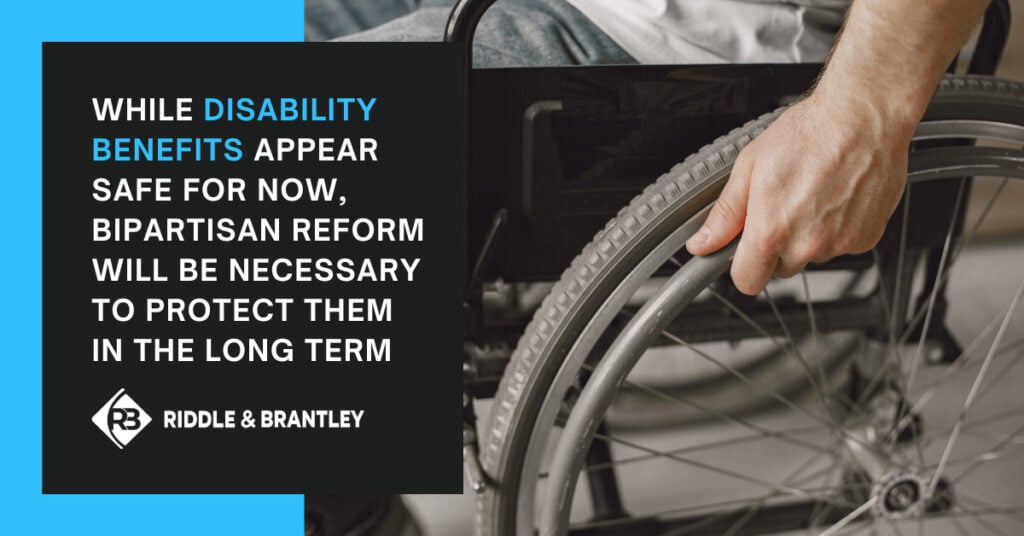What Will Happen to Disability Benefits if Social Security Runs Out of Money?
Concerned about your disability benefits if the Social Security program’s funding runs out?

As it currently stands, Social Security’s cash reserves will run out and benefit payments will be
cut in or around 2034.
Cuts to Social Security disability benefits will only happen, however, if Congress takes no action to reform Social Security’s financial mechanisms over the course of the next decade — and there is tremendous pressure
A large majority of Social Security funding is raised through tax revenue every year, with only
6.4% coming from the trust fund holdings that are facing depletion. If no action is taken and Social Security’s trust funds run out of money, benefits would be cut to
77% of their current levels starting in 2034.
This does not mean that Social Security will cease to exist or benefit payments will stop if nothing changes over the course of the next decade. In this scenario, Social Security benefits would remain in effect at a lower level.
Why Are Social Security’s Trust Funds Running Out of Money?
A combination of demographic changes have led to annual benefit payments to Social Security beneficiaries outpacing the program’s income.
People in the baby boom generation, which was the largest generation until it was surpassed by millennials in 2021, are
retiring at an increasingly fast rate. Older Americans today are also living longer than previous generations, meaning they will draw Social Security benefits for more years on average. Both trends are increasing the total number of Social Security beneficiaries, which has risen nearly 45% since 2000.
While Social Security continues to pay benefits to more and more retirees and individuals with disabilities, an overall decrease in the birth rate since the baby boom generation means that fewer workers are paying into the program. As a result, more money has to be taken out of Social Security’s trust funds each year to make up the difference.
Social Security Has Faced Crisis Before
This isn’t the first time that Social Security has faced financial crisis. In the late 1970s, the combination of economic stagnation and inflation created financial turmoil for Social Security, leading to
reforms passed in 1977.
These reforms didn’t fix the issues that Social Security faced, however, and the program found itself in financial distress again in the early 1980s. By 1983, Social Security was just
months away from facing trust-fund depletion.
A series of Social Security Act amendments passed in
1983, which included raising the full retirement age to 67 and taxing benefits for people over a certain income threshold, resolved its financial issues, allowing it to remain solvent through today.
What Will Happen to Disability Benefits?
For the time being, Social Security disability benefits appear to be safe.
Social Security includes two major trust funds:
- Old-Age and Survivors Insurance (OASI) Trust Fund
- Disability Insurance (DI) Trust Fund

The current financial situation for the DI Trust Fund is much better than the OASI Trust Fund. A June 2022 status report from the Social Security Administration projects that it will remain afloat until at least
2096.
Much of the DI Trust Fund’s solvency depends on how many people apply for disability benefits, which changes more frequently than the number of people applying for retirement benefits. As a result, the financial status of the trust fund can vary much more widely year-to-year compared to the rest of Social Security.
In 2021, the DI Trust Fund was expected to run out of money by 2057. Fewer people applied for disability benefits in 2022, however, leading to the updated 2096 projection. This is good news, but the trust fund could swing in the other direction just as easily if disability applications increase significantly in the coming years.
What Can Be Done to “Fix” Social Security?
In the most basic sense, three things can be done to make Social Security’s trust funds solvent beyond the 2030s:
- Cut how much the program pays out in benefits
- Increase how much revenue it brings in
- A combination of the two
Proposals
championed by President Joe Biden and many other Democrats in Congress were captured in the
Social Security 2100 Act, which was filed but not passed in 2021. This and similar proposals take the approach of increasing revenue.
The main financial mechanism in this legislation was an increase in Social Security taxes paid by higher-wage earners. The bill would increase the Social Security tax cap and re-apply a higher Social Security tax tier on wages over $400,000.
A 2023 federal budget plan from the Republican Study Committee (RSC) calls for benefit reductions to make up for the current financial imbalance. The RSC plan calls for benefit cuts for all beneficiaries except for low-income workers alongside an increase in the retirement age to 70.
The Bottom Line for Social Security
Social Security is facing serious financial issues, but the federal government does have time to implement a solution, especially compared to the 3-month window faced in 1983. It can be difficult to imagine Congress coming together to implement a solution, especially with Republican and Democrat proposals falling on opposite ends of the spectrum.
Among the public, however, there is wide bipartisan
support for most potential fixes to Social Security, including raising tax caps, reducing benefits for high-income earners, raising the retirement age, and increasing payroll taxes.
Need Help Securing Disability Benefits?
If you've been denied Social Security disability benefits, the
North Carolina disability lawyers at Riddle & Brantley may be able to help with an appeal. For a FREE, no-obligation case review, please call
1-800-525-7111 or complete the fast and easy form below. We don't get paid unless you receive disability benefits — it's simple as that. Call
1-800-525-7111 today and let's talk!
 As it currently stands, Social Security’s cash reserves will run out and benefit payments will be cut in or around 2034. Cuts to Social Security disability benefits will only happen, however, if Congress takes no action to reform Social Security’s financial mechanisms over the course of the next decade — and there is tremendous pressure
A large majority of Social Security funding is raised through tax revenue every year, with only 6.4% coming from the trust fund holdings that are facing depletion. If no action is taken and Social Security’s trust funds run out of money, benefits would be cut to 77% of their current levels starting in 2034.
This does not mean that Social Security will cease to exist or benefit payments will stop if nothing changes over the course of the next decade. In this scenario, Social Security benefits would remain in effect at a lower level.
As it currently stands, Social Security’s cash reserves will run out and benefit payments will be cut in or around 2034. Cuts to Social Security disability benefits will only happen, however, if Congress takes no action to reform Social Security’s financial mechanisms over the course of the next decade — and there is tremendous pressure
A large majority of Social Security funding is raised through tax revenue every year, with only 6.4% coming from the trust fund holdings that are facing depletion. If no action is taken and Social Security’s trust funds run out of money, benefits would be cut to 77% of their current levels starting in 2034.
This does not mean that Social Security will cease to exist or benefit payments will stop if nothing changes over the course of the next decade. In this scenario, Social Security benefits would remain in effect at a lower level.
 The current financial situation for the DI Trust Fund is much better than the OASI Trust Fund. A June 2022 status report from the Social Security Administration projects that it will remain afloat until at least 2096.
Much of the DI Trust Fund’s solvency depends on how many people apply for disability benefits, which changes more frequently than the number of people applying for retirement benefits. As a result, the financial status of the trust fund can vary much more widely year-to-year compared to the rest of Social Security.
In 2021, the DI Trust Fund was expected to run out of money by 2057. Fewer people applied for disability benefits in 2022, however, leading to the updated 2096 projection. This is good news, but the trust fund could swing in the other direction just as easily if disability applications increase significantly in the coming years.
The current financial situation for the DI Trust Fund is much better than the OASI Trust Fund. A June 2022 status report from the Social Security Administration projects that it will remain afloat until at least 2096.
Much of the DI Trust Fund’s solvency depends on how many people apply for disability benefits, which changes more frequently than the number of people applying for retirement benefits. As a result, the financial status of the trust fund can vary much more widely year-to-year compared to the rest of Social Security.
In 2021, the DI Trust Fund was expected to run out of money by 2057. Fewer people applied for disability benefits in 2022, however, leading to the updated 2096 projection. This is good news, but the trust fund could swing in the other direction just as easily if disability applications increase significantly in the coming years.